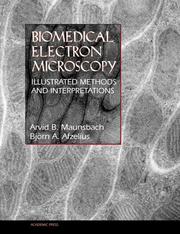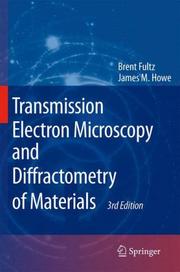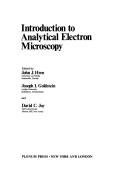| Listing 1 - 6 of 6 |
Sort by
|
Book
ISBN: 0713125217 0713125225 Year: 1976 Volume: 7 Publisher: London Arnold
Abstract | Keywords | Export | Availability | Bookmark
 Loading...
Loading...Choose an application
- Reference Manager
- EndNote
- RefWorks (Direct export to RefWorks)
Experimental solid state physics --- Optics. Quantum optics --- Materials. --- Electron microscopy. --- Matériaux --- Microscopie électronique --- Matériaux --- Microscopie électronique --- Materials --- Electron microscopy --- #KVIV --- Engineering --- Engineering materials --- Industrial materials --- Engineering design --- Manufacturing processes --- Microscopy

ISBN: 9780124806108 0124806104 9786611279486 128127948X 0080528090 9780080528090 9781281279484 6611279482 Year: 1999 Publisher: San Diego, Calif. Academic Press
Abstract | Keywords | Export | Availability | Bookmark
 Loading...
Loading...Choose an application
- Reference Manager
- EndNote
- RefWorks (Direct export to RefWorks)
This comprehensive reference illustrates optimal preparation methods in biological electron microscopy compared with common methodological problems. Not only will the basic methodologies of transmission electron microscopy like fixation, microtomy, and microscopy be presented, but the authors also endeavor to illustrate more specialized techniques such as negative staining, autoradiography, cytochemistry, immunoelectron microscopy, and computer-assisted image analysis.Key Features* Authored by the key leaders in the biological electron microscopy field* Illustrates both optimal
Cytodiagnosis --- Microscopy, Electron --- Electronics, Medical --- Tissue Fixation --- Electron microscopy --- Medical electronics. --- Microscopie électronique --- Electronique en médecine --- methods --- Technique. --- Technique --- Medical microscopy --- Microscopie électronique --- Electronique en médecine --- ELSEVIER-B EPUB-LIV-FT --- Microscopy, Medical --- Diagnosis, Laboratory --- Microscopy --- Electron microscopes

ISBN: 9783540738862 9783540738855 3540738851 Year: 2008 Publisher: Berlin, Heidelberg Springer-Verlag Berlin Heidelberg
Abstract | Keywords | Export | Availability | Bookmark
 Loading...
Loading...Choose an application
- Reference Manager
- EndNote
- RefWorks (Direct export to RefWorks)
This book explains concepts of transmission electron microscopy (TEM) and x-ray diffractometry (XRD) that are important for the characterization of materials. The third edition has been updated to cover important technical developments, including the remarkable recent improvement in resolution of the TEM. This edition is not substantially longer than the second, but all chapters have been updated and revised for clarity. A new chapter on high resolution STEM methods has been added. The book explains the fundamentals of how waves and wavefunctions interact with atoms in solids, and the similarities and differences of using x-rays, electrons, or neutrons for diffraction measurements. Diffraction effects of crystalline order, defects, and disorder in materials are explained in detail. Both practical and theoretical issues are covered. The book can be used in an introductory-level or advanced-level course, since sections are identified by difficulty. Each chapter includes a set of problems to illustrate principles, and the extensive Appendix includes laboratory exercises. ``I can warmly recommend this book, which is attractively priced, as an excellent addition for any materials scientist or physicist who wants a good overview of current diffraction and imaging techniques.'' John Hutchison in Journal of Microscopy ``I can recommend it as a valuable resource for anyone involved in a higher-level course on materials characterization.'' Ray Egerton in Micron ``A wonderful book. A rare combination of depth, practical advice, and problems for every aspect of modern XRD, TEM, and EELS. No materials lab should be without it now that TEM/STEM has become such a crucial tool for nanoscience.'' John C. H. Spence, Arizona State University ``I give a lecture course here on Advanced Electron Microscopy and will certainly be recommending your book for my course. It is a superb book.'' Colin Humphreys, Cambridge University ``This text offers the most complete pedagogical treatment of scattering theory available in a single source for graduate instruction in contemporary materials characterization. Its integration of photons and electrons, beam lines and electron microscopes, theory and practice, assists students with diverse scientific and technical backgrounds to understand the essence of diffraction, spectrometry and imaging. Highly recommended.'' Ronald Gronsky, University of California, Berkeley
Solid state physics --- Physics --- Chemical and physical crystallography --- Materials sciences --- elektronenmicroscopie --- kristallografie --- materiaalkennis --- toegepaste wetenschappen --- spectroscopie --- fysica --- fysicochemie --- Materials --- Transmission electron microscopy --- X-ray diffractometer. --- Matériaux --- Microscopie électronique à transmission --- Diffractomètres à rayons X --- Microscopy --- Microscopie --- EPUB-LIV-FT SPRINGER-B LIVCHIMI

ISBN: 0306402807 147575583X 1475755813 Year: 1979 Publisher: New York (N.Y.): Plenum
Abstract | Keywords | Export | Availability | Bookmark
 Loading...
Loading...Choose an application
- Reference Manager
- EndNote
- RefWorks (Direct export to RefWorks)
Experimental solid state physics --- Spectrometric and optical chemical analysis --- fysicochemie --- Biological microscopy --- Microscopy, Electron --- Electron microscopy --- Microscopie électronique --- 621.385 --- 620.18 --- Microscopy --- Apparatus employing electron discharges. Electron tubes. Thermionic vacuum tubes (thermionic valves) --- Investigation of structure of materials. Metallography. Analogous study of non-metals --- Electron microscopy. --- 620.18 Investigation of structure of materials. Metallography. Analogous study of non-metals --- 621.385 Apparatus employing electron discharges. Electron tubes. Thermionic vacuum tubes (thermionic valves) --- Microscopie électronique --- Microscopy, Electron.

ISBN: 128061143X 9786610611430 1402039204 1402039182 1402039190 9781402039188 9781402039195 9781402039201 Year: 2006 Volume: 211 Publisher: Dordrecht Springer
Abstract | Keywords | Export | Availability | Bookmark
 Loading...
Loading...Choose an application
- Reference Manager
- EndNote
- RefWorks (Direct export to RefWorks)
During the last decade we have been witness to several exciting achievements in electron crystallography. This includes structural and charge density studies on organic molecules complicated inorganic and metallic materials in the amorphous, nano-, meso- and quasi-crystalline state and also development of new software, tailor-made for the special needs of electron crystallography. Moreover, these developments have been accompanied by a now available new generation of computer controlled electron microscopes equipped with high-coherent field-emission sources, cryo-specimen holders, ultra-fast CCD cameras, imaging plates, energy filters and even correctors for electron optical distortions. Thus, a fast and semi-automatic data acquisition from small sample areas, similar to what we today know from imaging plates diffraction systems in X-ray crystallography, can be envisioned for the very near future. This progress clearly shows that the contribution of electron crystallography is quite unique, as it enables to reveal the intimate structure of samples with high accuracy but on much smaller samples than have ever been investigated by X-ray diffraction. As a tribute to these tremendous recent achievements, this NATO Advanced Study Institute was devoted to the novel approaches of electron crystallography for structure determination of nanosized materials.
Crystallography --- Electron microscopy --- Cristallographie --- Microscopie électronique --- Congresses. --- Congrès --- EPUB-LIV-FT LIVPHYSI Nanosized SPRINGER-B materials --- Congresses --- Crystallography. --- Surfaces (Physics). --- Mineralogy. --- Catalysis. --- Crystallography and Scattering Methods. --- Characterization and Evaluation of Materials. --- Surfaces and Interfaces, Thin Films. --- Activation (Chemistry) --- Chemistry, Physical and theoretical --- Surface chemistry --- Physical geology --- Minerals --- Physics --- Surfaces (Technology) --- Leptology --- Physical sciences --- Mineralogy --- Materials science. --- Materials—Surfaces. --- Thin films. --- Films, Thin --- Solid film --- Solid state electronics --- Solids --- Coatings --- Thick films --- Material science --- Materials --- Surfaces. --- Surface phenomena --- Friction --- Surfaces (Physics) --- Tribology --- Surfaces
Periodical
ISSN: 02484900 1768322X Year: 1962 Publisher: Paris Ivry sur Seine Paris Elsevier Société française de microscopie électronique Société française de microscopie électronique
Abstract | Keywords | Export | Availability | Bookmark
 Loading...
Loading...Choose an application
- Reference Manager
- EndNote
- RefWorks (Direct export to RefWorks)
Biology of the Cell publishes original research articles and reviews on all aspects of cellular and molecular biology, development and cell physiology. Of particular interest are contributions directed towards understanding structure-function relationships with respect to basic cell and tissue functions, development, neurobiology, immunology, microbiology and protistology and plant biology. Theoretical and biophysical models on any aspect of cell function can be submitted. Descriptions of methods will be considered but their validity should be demonstrated by one or more applications. The Journal also publishes a specific discussion and general interest section called Scientiae Forum, that will include articles on the following topics: Models and Speculations, on all aspects of cell structure and function, Primer reviews aimed at opening-up specific topics to scientists working in unrelated fields of interest, and History of Biology of the Cell that will situate the present research in the life sciences within its historic context.
Histology. Cytology --- Genetics --- Cytology --- Electron microscopy --- Cytologie --- Microscopie électronique --- Periodicals --- Périodiques --- Cell Biology. --- Microscopes électroniques --- Cytology. --- Electron microscopy. --- 57 --- 576 --- Biological sciences in general --- Cellular and subcellular biology. Cytology --- Health Sciences --- Immunology --- General and Others --- Life Sciences --- Biology --- Health Sciences. --- General and Others. --- Life Sciences. --- 576 Cellular and subcellular biology. Cytology --- Microscopie électronique --- Périodiques --- EJBIOLO EJBIOMO EJMEDEC ELSEVIER-E EPUB-ALPHA-B EPUB-PER-FT MDBIOLOG MDCYTOLO WILEY-E --- Cell biology --- Cellular biology --- Cellular Biology --- Biologies, Cell --- Biologies, Cellular --- Biology, Cell --- Biology, Cellular --- Cell Biologies --- Cellular Biologies --- Microscopy --- Cells --- Cytologists --- Microscopes électroniques --- MDBIOLOG MDCYTOLO --- Cell Biology --- Journal --- Electron microscopes --- Cytologie. --- Electron microscope --- Microscopes --- Electron microscopes. --- Cytology - Periodicals --- Electron microscopy - Periodicals --- Cytopathology --- Cytopathologies
| Listing 1 - 6 of 6 |
Sort by
|

 Search
Search Feedback
Feedback About UniCat
About UniCat  Help
Help News
News